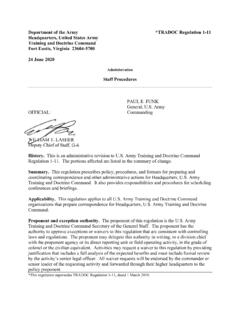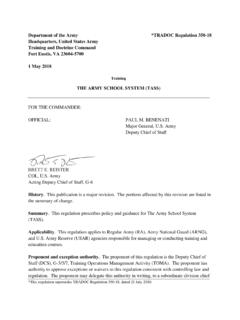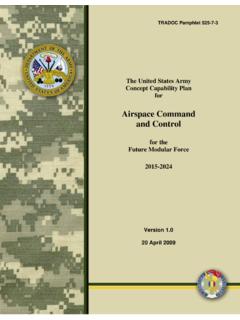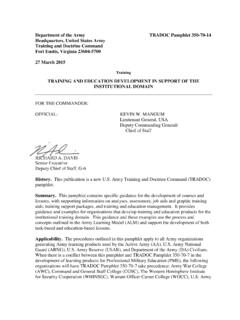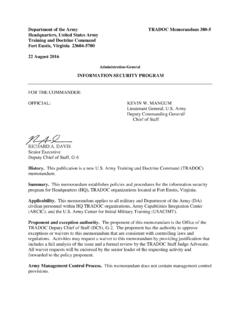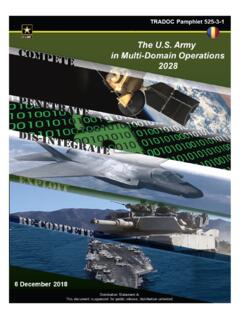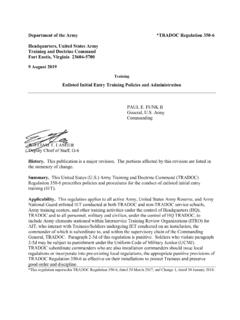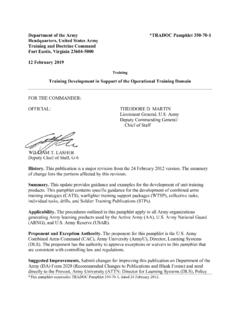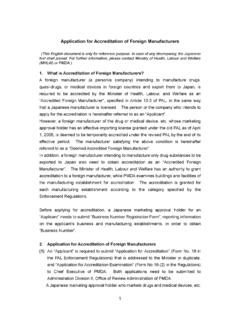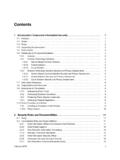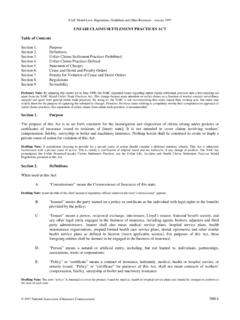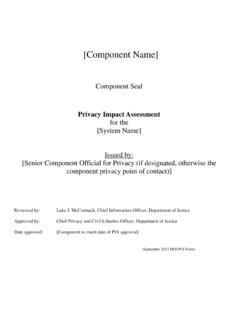Transcription of O-6 Draft of TRADOC Pamphlet 350-70-7 - United States Army
1 Department of the Army TRADOC Pamphlet 350-70-7 . Headquarters, United States Army Training and Doctrine Command Fort Eustis, Virginia 23604-5700. 4 October 2018. Army Learning ARMY EDUCATIONAL PROCESSES. _____. FOR THE COMMANDER: OFFICIAL: THEODORE D. MARTIN. Lieutenant General, Army Deputy Commanding General/. Chief of Staff BRETT E. REISTER. Colonel, Army Acting Deputy Chief of Staff, G-6. History. This publication is a major revision and aligns with the Army Training and Doctrine Command ( TRADOC ) Campaign of Learning. Summary. This Pamphlet provides guidance to institutions that provide professional military education (PME). It presents general principles of education for learning, curriculum development, teaching, assessment, and evaluation.
2 This guidance supports the concepts outlined in the Army Learning Concept for Training and Education (ALC-TE) and describes the processes that guide curriculum development and educational instruction. This guidance aligns with policy set forth in TRADOC Regulation (TR) 350-70 (Army Learning Policy and Systems). Applicability. This Pamphlet applies to the following Army educational institutions: Army War College;. Army Command and General Staff College (CGSC);. Warrant Officer Career College;. Army Management Staff College;. Defense Language Institute Foreign Language Center (DLIFLC);. The Sergeants Major Course within the NCO Leadership Center of Excellence and the Army Sergeants Major Academy. *This Pamphlet supersedes TRADOC Pamphlet 350-70-7 , dated 9 January 2013.
3 TRADOC Pamphlet 350-70-7 . The School for Professional Military Education at the Western Hemisphere Institute for Security Cooperation. All Captains Career Courses at Army branch schools; and Reserve Component - The Army School System organizations providing Army education courses to resident and non-resident student populations. This Pamphlet also applies to select courses and programs at the following organizations and schools: The Combined Arms Support Command;. The Army Medical Department Center and School;. The Judge Advocate General's Legal Center and School;. Army Cadet Command Finally, this Pamphlet applies to other TRADOC and non- TRADOC agencies and organizations possessing memoranda of understanding, memoranda of agreement, and contracts for developing educational learning products for TRADOC and Reserve Component - The Army School System agencies and organizations.
4 For other institutions, TRADOC Pamphlet (TP) 350-70-14 (Training and Education Development in Support of the Institutional Training Domain) should provide sufficient guidance for the development of both topic-based and task-based curriculum without the need to reference this Pamphlet also. Proponent and exception authority. Headquarters, Army University (Army U), Fort Leavenworth, Kansas is the proponent for TP 350-70-7 . The Provost, Army U is the authority to approve exceptions or waivers to this Pamphlet consistent with controlling laws and regulations, unless otherwise designated. The Provost, Army U will consider and grant exceptions to policy and/or waivers on an individual basis. The commander/commandant or senior leader of the requesting activity must endorse all exception/waiver requests before forwarding them through appropriate higher headquarters to the policy proponent.
5 Requests must include requestor contact information; type of request (initial, extension, modification, appeal, or cancellation); specific Pamphlet line items requested for exception/waiver; the requesting unit; the affected institution, center, or school; a proposed alternative; justification; impact; expected benefits; anticipated effective dates; and duration requested. The proponent seeks continual innovation and process improvement. The proponent must consider significant process improvements and global exceptions for addendum to policy prior to the next revision. Suggested improvements. Submit changes for improving this publication on Department of the Army (DA) Form 2028 (Recommended Changes to Publications and Blank Forms) directly to the Provost, Army University, Attention (ATTN): Director for Learning Systems (DLS), Policy and Governance Division (PGD) (ATZL-AUL), Fort Leavenworth, KS 66027-2300.
6 Additionally, individuals and organizations may send comments electronically using Army Distribution. The official published version of this Pamphlet is available only on the TRADOC . Administrative Publications website ( ). 2. TRADOC Pamphlet 350-70-7 . Summary of Change TRADOC Pamphlet 350-70-7 . Army Educational Processes This major revision, dated 4 October 2018- o Broadens discussion of the education processes to describe foundational adult learning concepts and their application to teaching and learning in educational institutions and schools (chap 1). o Adds a chapter addressing external accrediting bodies and accreditation considerations (chap 2). o Moves the former Chapter 3. Evaluation to become the new chapter 7 (chap 7).
7 O Refines discussion regarding accreditation and evaluation processes to recognize the varied requirements and approaches at individual institutions (chaps 2 and 7). o Adds a chapter on teaching to describe the expectations and competencies for instructors in educational institutions, describes the concept of adult learning and the Army University Experiential Learning Model, and emphasizes strengthening adaptive thinking to better support the Army Learning Concept for Training and Education (chap 3). o Adds a chapter on learning that addresses teaching versus learning and classroom assessments (chap 4). o Integrates the former Chapter 2. The Analysis, Design, Development, Implementation, and Evaluation (ADDIE) Process into a new chapter 5 addressing curriculum development and develops the hierarchy of educational outcomes, objectives, and standards (chap 5).
8 O Provides references and examples for curriculum developers preparing courseware for delivery in learner-centric collaborative learning settings that emphasize critical thinking and problem solving skills (chap 5). o Expands the discussion of assessment of student learning, provides the characteristics of learning assessment programs, and addresses feedback to students regarding assessments as they relate to educational institutions (chap 6). o Updates appendix A, Section I Required Publications with two United States Army Training and Doctrine Command regulations, three training pamphlets, an Army University white paper, and an Army doctrinal reference publication (app A). o Replaces Appendix B. Relationships among Learning Domains, Levels of Learning, and Learning Objectives with a new Appendix B.
9 Examples of Army Enterprise accreditation Standard (AEAS) Rubrics for the Faculty and Staff Development Standard, AEAS-6 (app B). 3. TRADOC Pamphlet 350-70-7 . o Deletes Appendix C Assessment Instruments, Appendix D Examples of Lesson Plans, and Appendix E Rubric Examples. o Deletes five tables addressing an assessment matrix and United States Army Command and General Staff College enterprise standards rubrics (chap 2 and appendix E). o Moves the Accountable Instructional System figure from chapter 2 to chapter 5 (chapters 2. and 5). o Deletes five figures from chapter 2, chapter 4, and appendixes B and E (chapters 2 and 4, appendixes B and E). 4. TRADOC Pamphlet 350-70-7 . Contents Page Chapter 1 Introduction.
10 7. 1-1. Purpose .. 7. 1-2. Scope .. 7. 1-3. References .. 7. 1-4. Explanation of Abbreviations and Terms .. 7. 1-5. Army Educational Processes Overview .. 7. 1-6. Philosophy of Educational Institutions .. 8. Chapter 2 accreditation Considerations .. 9. 2-1. Army accreditation .. 9. 2-2. The Influence of External Accrediting Bodies on Army Educational 9. Chapter 3 Teaching .. 11. 3-1. Adaptive Instructors .. 11. 3-2. United States ( ) Army Training and Doctrine Command ( TRADOC ) Instructor Competencies .. 12. 3-3. Instructor as a Professional .. 12. 3-4. Adult Learning and Army University (Army U) Experiential Learning Model .. 13. 3-5. Strengthening Adaptive Thinking .. 17. Chapter 4 Learning .. 18. 4-1. Teaching versus 18.
